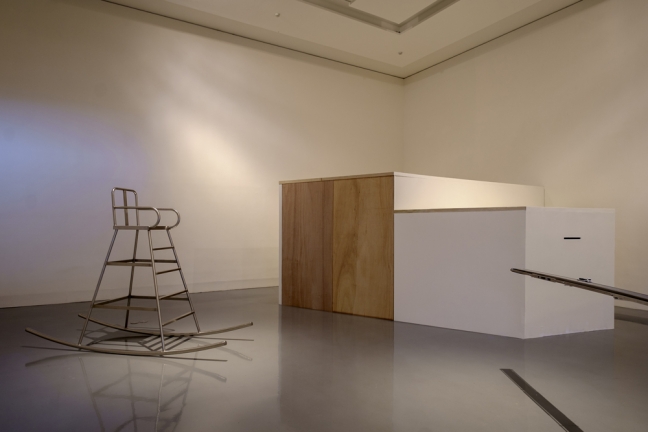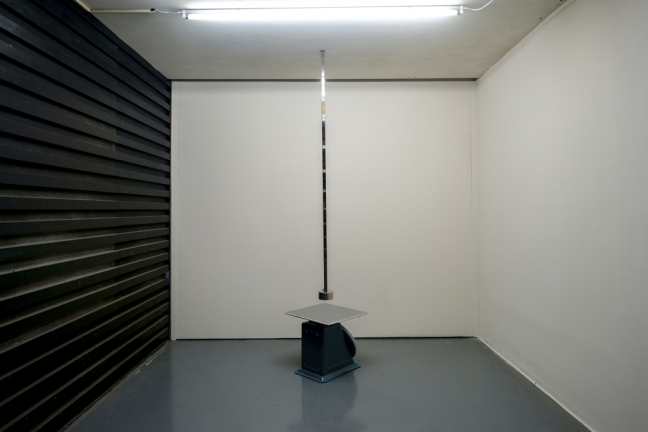

指物-創作卓越獎
關渡美術館,臺北
Indexing–2016 Outstanding Art Prize Exhibition
Kuandu Museum of Fine Arts, Taipei
2016
現實世界是我們感官所知的外在世界組成,真實世界則是由一連串的語言與文字所構成。現實與真實,映射的是實體世界的客觀存在、思維世界的主觀存在。 我們認識外在世界,透過感官感受「外在世界」,透過感受的經驗,在心中找尋描述對應的「語言」。
而做為主體的「我們」,用著「語言」連結「外在世界」,這是一個「指物」1的歷程。 「所以謂,名也;所謂,實也」2在指物歷程中,「名」代表了人工制定的概念之知與思惟的內容。它是一套貼著世界描述的語言工具,書寫單位的有效編碼。謂名的同時,揭露了人類價值性判斷,這牽涉、表達了個人愛好、態度與情感傾向。
古老的藝術正好是一種描繪現實世界的「指物」工作,作品如「名」般與文字工具同樣有效。而今,當代藝術的語境脈絡已脫離以往精準描述世界的科學語言,為一使用不同的物件、概念、後設語言編織而成的詩性語言,不再追求「名實耦,合也」的有效性。
本展以樸實名實論試圖映射出當代藝術的「指物」工作:以感知經驗模擬真實,而非追求再現現實的「感覺擬態」;人的主觀「自見之」、「自聞之」3永遠受「意識的幽魂」左右決定;而不斷採取「後設之後」姿態解構的文本作品,使當代藝術的指物歷程呈現飄移,「名」成為一種私語言的樣態。
備註
1.「指物」一詞出自於 公孫龍〈指物論〉,其核心為「物莫非指,而指非指」,「指」決定了「物」,概念決定了事物的觀點,沒有「指」,物就不成其「物」。
2.「所以謂,名也;所謂,實也。名實藕,合也,志行,為也。」此句出自於〈墨子˙經說上〉。名實強調偶合性的因果關係,在行為上則以志行是否一致為標準,因此名有單純描述與評價兩種功能。
3「自見之」、「自聞之」皆出自於鄧析子〈無厚〉,原句為「夫自見之明,借人見之闇也。自聞之聰,借人聞之聾也。」,強調人的主觀意識能決定萬物。
The realistic world is composed of what we sense and therefore understood as the external world”, while the truth of this world is formed by series of words and languages.
The materialistic and the truth, one refers to the tangible, objective being, while the other reflects the intangible, subjective perception of the mind. We experience the external world” as we known through our senses, and then match the experience with the proper language” internally. We”, as the subjective body, connecting with the external world” through uses of language, is a process described as 指物” (Zhǐwù) ― designation/ Indexing. ‘名’ (the name, or sign) is the reference; ‘實’ (the object) is the referent.” During the course of designation, the ”name” represents the content of an artificially developed concept or knowledge. It is a language tool akin to how we describe the world, an effective code used as writing unit. The process of naming and designation unveils the human value judgement, which also involves expression of personal preference, attitude, and emotional tendency.
Ancient artworks depicting the real world is exactly designation at work. lt functions effectively just like the linguistic tool of names and sings. Today, the expressive context of the contemporary art has departed from the kind of precise depiction with scientific language in the past, and became a form of poetic language that draws from various objects, concepts, and meta-languages. It no longer pursuits the effective matching of reference and referent.”
This exhibition attempts to reflect on the designation/ Indexing” at work in contemporary art with the simple theory of sign and object: simulating the truth with sensual experiences, rather than the pursuit of reproducing reality through "sencial mimicry"; The human subjective "seeing for oneself", "hearing for oneself" is forever influenced by the "ghost of the sense"; as the artwork continually to deconstruct from a "post-meta" stance, it presents the designation process of contemporary art as a drift. The name/sing then become a form of private language.
Note
1. The term指物”(Zhǐwù) originates from Gongsun Long’s work On Pointing at Things/The Theory of Sign and Object” . Its core concept of the reference determines the referent”- has set the perception of how we interpret the world. Without a reference, there is no referent.
2. What something is called by is its 'name'. What is so called is the 'object'. The mating of 'name' and 'object' is 'relating'. To intend and to perform are to 'act'”. are both originated from Jīng Suǒ Chapter, Mozi.” Name” and object” the coupling of causality in behavior places, emphasize person thought and actual behavior consistent. So, Name” possess described and evaluated two functions.
3. "Seeing for oneself" and "hearing for oneself" are both originated from the Wú Hòu Chapter, Deng Xi Zi”. The original line being:Those who see through their own eyes are wise, while those who rely on other’s opinion are ignorant; those who listen with their own ears are clever, while those who rely on others for the news are deaf”, emphasizing that the human subjective mind determines everything.
Related Works